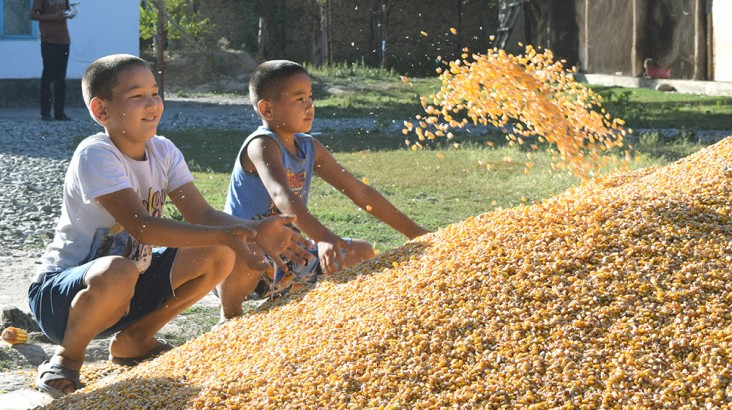
November 2016—Nearly all farmers in the southern oblast of Jalal-Abad in Kyrgyzstan grow maize according to traditional methods—with outdated techniques and high manual labor—which limit profitability. Often, the maize they grow for animal feed is not enough, so they must buy additional feed to get through the winter.
Kadyrbek Baratov, a 35-year-old maize farmer, is no exception. He learned everything from his father, using the same approach.
“In the past, 0.5 hectares would give a maximum of 3 tons of maize. My entire family, including my wife, my sons, aged 9 and 7, and my 5-year-old daughter helped me in the field. We had to work hard together,” says Baratov.
In January 2016, he joined USAID’s Agro Horizon Project along with 2,200 other farmers in Jalal-Abad and Osh oblasts to learn new agricultural technologies that promised to double his yield.
They attended special training classes as well as hands-on field demonstrations to learn latest best practices in advanced maize growing. To make sure the new knowledge is put into practice, USAID and farmers shared the costs of new high-quality hybrid maize seeds, fertilizers and pesticides. The farmers also received free mechanized services including soil preparation, harrowing, spraying, cultivation and harvesting to demonstrate the effectiveness of machinery.
Six months later, to his surprise, Baratov did double his yield. “It’s like a present to my family,” he says. But he seems even more excited that using machinery helped his wife spend more time with their children and kept them at school during the harvesting season. “Even I had more time to complete the construction of our house,” added Baratov.
The project demonstrated that the comprehensive approach is effective not only in select cases. All of the project participants reported doubling their maize yield by using technology, high-quality inputs and advanced maize growing practices.
“I will keep a part of the yield to feed my cattle during the winter. I will sell the rest and, with the profit, I’ll purchase coal for heating the house in winter and buy a bicycle for my kids,” says Baratov.
The USAID Agro Horizon Project, which runs from October 2014 through September 2018, aims to raise smallholder farmers’ incomes by expanding markets and increasing the competitiveness of targeted agro sectors. The project increases employment in the agricultural sector, especially for women and youth, while improving the availability of nutritious foods.
LINKS







Comment
Make a general inquiry or suggest an improvement.